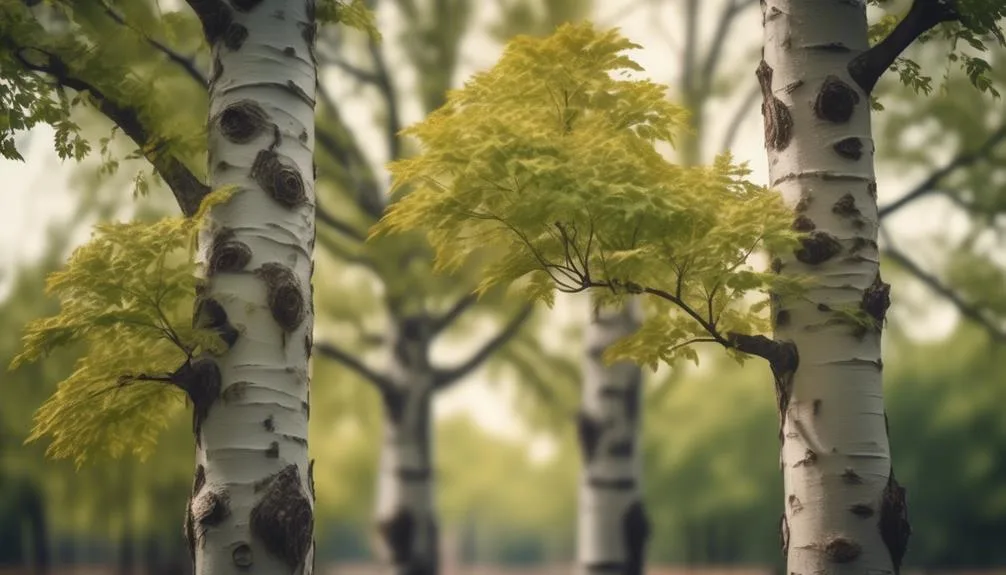Grafting hickory trees may seem challenging, but it's entirely achievable with the right knowledge and techniques. By grafting, you can combine different hickory varieties to create a tree with multiple desirable traits.
Picture enjoying delicious nuts while benefiting from disease resistance. Interested in learning more?
We'll explore the types of hickory trees suitable for grafting, the best techniques to use, and the key factors for successful grafting.
Types of Hickory Trees for Grafting
When choosing hickory trees for grafting, it's essential to select varieties that are well-suited to your specific climate and soil conditions. Grafting hickory trees can present challenges, particularly when it comes to tree compatibility. It's crucial to consider the compatibility of the scion (the upper part of the graft) and the rootstock (the lower part) to ensure a successful graft.
Hickory trees, known for their strength and beautiful wood, come in different varieties such as shagbark, shellbark, and pecan hickory. Each variety has its own characteristics and growth habits, so understanding these factors is vital for successful grafting.
For instance, shellbark hickory is well-suited to moist, rich soils, while shagbark hickory is more adaptable to a range of soil conditions. Understanding these differences will help ensure a successful graft and healthy tree growth.
Suitable Grafting Techniques for Hickory Trees
To successfully graft hickory trees, it's crucial to employ suitable grafting techniques that ensure the compatibility and healthy integration of the scion and rootstock. Here are three essential considerations for grafting hickory trees:
- Bud Grafting and Whip Grafting Techniques:
Explore and understand the specific requirements and nuances of bud grafting and whip grafting techniques. Each method has its own advantages and challenges, and mastering both will increase your chances of successful grafting.
- Rootstock Selection:
Carefully select the rootstock for grafting. Consider factors such as disease resistance, compatibility with the scion, and adaptability to your local climate.
- Scion Preparation:
Ensure that the scion, the part of the plant that will produce the desired fruit or nut, is healthy and prepared correctly. This involves proper cutting, handling, and storage to maximize the success of the graft.
Compatible Hickory Tree Varieties for Grafting
Exploring suitable hickory tree varieties for grafting is essential to ensure successful compatibility and healthy integration, building on the foundation of suitable grafting techniques discussed previously.
When selecting compatible varieties for grafting, it's crucial to consider the challenges associated with hickory tree grafting. Some hickory tree varieties may pose challenges due to differences in growth habits, bark texture, or genetic compatibility.
Additionally, climate considerations play a significant role in determining compatible hickory tree varieties for grafting. Varieties that are well-suited to the specific climate conditions of your region are more likely to thrive and integrate successfully.
Understanding the unique characteristics and requirements of different hickory tree varieties will help you overcome grafting challenges and select the most compatible varieties for successful grafting.
Best Time for Grafting Hickory Trees
Consider the spring season as the best time for grafting hickory trees, as this period offers optimal conditions for successful graft integration and growth. During spring, the trees are actively growing, which increases the likelihood of the graft taking hold. Here's what you need to know:
- Pruning techniques: Prune the hickory trees before grafting to remove any diseased or damaged branches, ensuring the tree is in the best possible condition for successful grafting.
- Grafting tools: Make sure you have the right tools for the job, including a sharp grafting knife, grafting tape or rubber bands, and grafting wax to seal the graft union and protect it from drying out.
- Timing is crucial: Aim to graft the hickory trees when the sap is flowing, typically in early spring. This is when the trees are most receptive to grafting, increasing the chances of a successful union.
Tips for Successful Grafting of Hickory Trees
After pruning the hickory trees and preparing the grafting tools, you can ensure successful grafting by following these essential tips.
Firstly, make sure to select healthy scion wood from the tree you want to propagate and use sharp, sterile grafting tools to make clean cuts.
When making the grafting cuts, ensure they've matching cambium layers to promote successful healing and growth.
It's crucial to secure the graft union tightly to prevent movement and aid in the healing process. Additionally, protect the graft from harsh environmental conditions by using grafting wax or tape.
It's important to monitor the grafting process carefully, keeping an eye out for any signs of failure or infection.
Conclusion
Incorporating the right techniques and compatible varieties, hickory trees can indeed be successfully grafted to yield new hybrids with desirable traits.
By selecting the appropriate hickory tree variety, employing suitable grafting techniques, and timing the grafting process optimally, one can achieve fruitful results.
Happy grafting!
Mark Hoffman is a dedicated arborist and tree care specialist with over a decade of experience. His love for trees began when he visited Yosemite National Park as a teenager and was awestruck by the giant sequoias. Mark pursued his passion by studying forestry at Michigan Technological University, where he earned a Bachelor of Science degree.
Since then, he has worked tirelessly in the field of arboriculture, helping to preserve and protect trees in his community. His expertise and dedication have made him a respected leader in the industry and a valuable resource for anyone seeking advice on tree care.
